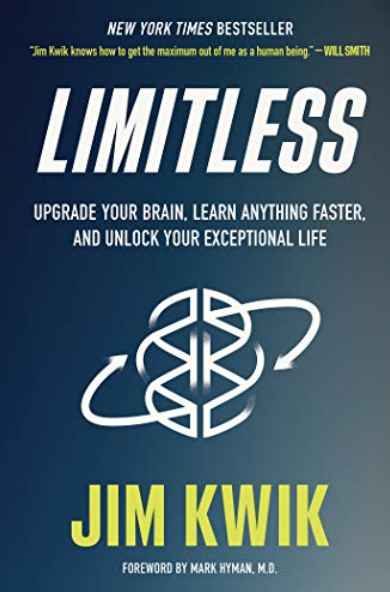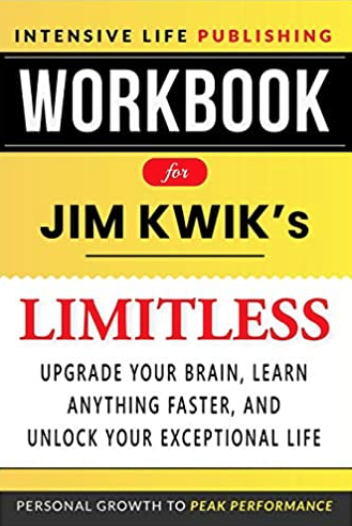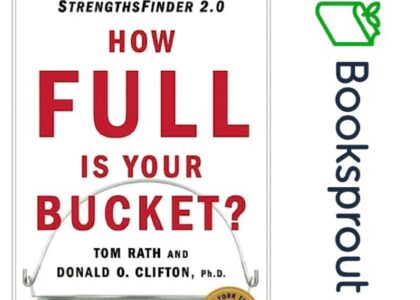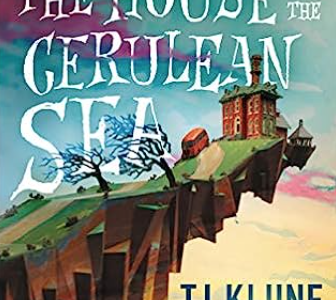Tuesday, May 11, 2021 – Part 1: Free Your Mind
Reviewing Jim Kwik’s “Limitless” Book in Four Parts Using Unofficial Workbook
Welcome to my Reading Tuesday’s B.R.E.A.T.H.S. blog. For my second Reading Tuesday’s I will be reviewing Jim Kwik’s book “Limitless” while using “Workbook for Jim Kwik’s Limitless,” an unofficial guide by Intensive Life Publishing. The workbook is written in four parts, so I will cover one part each week giving my personal insights on becoming limitless by reflecting, setting goals, and taking action. Jim’s #1 message that came through to me while I first listened to his book was to teach what I learn and that is what I am here to do with this blog. Follow along the next four weeks as I dive deep into how to upgrade my brain, read faster, comprehend more, and improve my memory recall.

Last year in 2020, I stumbled across a new book being promoted by HayHouse Publishing for only $1.99 for the ebook, “Limitless” by Jim Kwik. The title and price seemed right, so I made the purchase. A few months later, I saw there was an audio version on my HayHouse Unlimited Audio app and decided to give it a listen. As an educator, I loved what I was hearing about how we learned to read wrong, how we can relearn how to read faster, comprehend more, and be able to read about 30 books a year. The only problem was the book gave the reader action steps to learn how to read faster and I was listening and not improving my reading skills.

After listening to the book a couple times, I decided to see if there was an accompanying workbook to follow along. I found one on Amazon, but it was not produced by the author, Jim Kwik, and there’s a note inside to readers that it is an unofficial workbook. I decided to buy the workbook anyway and used it along with my copy of the ebook. The workbook takes the 15 chapters of the “Limitless” book and breaks it down into four parts:
PART 1 – Free Your Mind (Chapters 1 – 4)
PART 2 – Limitless Mindset: The What (Chapters 5 & 6)
PART 3 – Limitless Motivation: The Why (Chapters 7 – 10)
PART 4 – Limitless Methods: The How (Chapters 11 – 15)
Each of the four parts breaks down the chapters for the reader by including:
- Summary of the chapter
- The author’s takeaway
- Points for reflection
- Goals
- Action steps
Today, I will be discussing my findings from Part 1 – Free Your Mind that integrates chapters one through four covering my personal thoughts: points for reflection, goals, and action steps.
Chapter 1 – Becoming Limitless
*POINTS FOR REFLECTION:
- What is it about Jim’s story that you feel you can relate to?
- Fear of reading or speaking aloud. Reading was and still is an escape.
- Why is it important to be mindful of what we say to children?
- What we say externally, children will internalize for eternity.
- What are your limiting beliefs?
- I don’t know how, I read/write slowly, I am not prosperous, I can’t stop subvocalizing.
*GOALS:
- Being aware of what keeps you from becoming limitless, what do you think you would do to break those perceived limitations that have shaped your journey?
- Learn how to ask the right questions when I do not know something. Practice reading/writing daily. Replace my negative limiting thoughts with positive affirmations. Practice meditation.
- Where do you think you should start your journey to becoming limitless?
- Right now, read at least 20 minutes a day, take notes while reading to better comprehend.
*ACTION STEPS:
- Visualization: take time to visualize your dream and the things you want to achieve. Create a vision board, if necessary, to remind you of your goals
Chapter 2 – Why This Matters Now
*POINTS FOR REFLECTION:
- What have you understood about these digital villains?
- Digital Deluge = information overload
- Digital Distraction = consumed by cell phones
- Digital Dementia = overuse of technology leading to less cognitive recollection
- Digital Deduction = inability to formulate own thoughts without using technology
- Can you recall a point in your life when you have encountered any of these digital villains? How did they affect you?
- Digital Deluge-when I am researching for information on a topic and finding quality writings
- Digital Distraction-I have to hide my phone everyday so that I can get some time without it
- Digital Dementia-I cannot remember anyone’s current phone number
- Digital Deduction-I often turn to Google answers I don’t know off the top of my head
- They all affected my ability to recall and comprehend information.
- Why do you think consciousness is important in becoming limitless?
- Technology puts us on autopilot, consciousness puts us in the present.
*GOALS:
- How would you make use of technology without risking your mental health?
- I would limit my use by using timers and use positive affirmations while using technology (Louise Hay trick).
- What are the necessary adjustments that you should make given the effect of the four horsemen on your mental health? How would you keep things balanced?
- Moderation, put use of technology on the calendar, and use friendly notifications to take breaks.
*ACTION STEPS:
- Creating a Habit: Start a habit of taking time away from technology for at least 30 minutes every week (I crossed out week and wrote “Day”). Allot this time to doing something creative or simple. Do something that would help you relax. Turn off your phone when you need to. Relax and be creative.
- Each week I volunteer at the Kindness Farm where they grow fresh fruits and vegetables for the homeless in our community. This way I am getting outside, being creative with my hands, getting some exercise, working with other volunteers, and helping others. On days I am not at the farm, I am walking around neighborhood parks and gardens enjoying nature.
Chapter 3 – Your Limitless Brain
*POINTS FOR REFLECTION:
- Can you recall a time when you believed other people’s perceived notions about you? How did it make you feel?
- All the way up until my forties, I cared what others thought about me. After reading several books by my favorite authors like, Brene Brown (shame expert), Byron Katie (loving oneself expert), and Terry Cole-Whittaker (not caring what others think expert), I gained valuable insight on letting go of others limiting beliefs of myself. I started to do what I love to do with no regrets.
- If you had to choose between the red pill and the blue pill in the Matrix, which one would you choose? Why?
- I would choose the red pill to be freed from the control of the Matrix, free to make my own choices.
*GOALS:
- Why do you think it’s important to be mindful of your thoughts?
- You are what you think. Dr. Wayne Dyer explains this in his book, Change Your Thoughts Change Your Life, living your life by Tao Te Ching.
- Choosing your thoughts impacts your brain. Given that whatever you think could make or break you, how can you train yourself to choose the right thoughts?
- Practicing saying positive affirmations.
- Now that you know that you have the power to live an exceptional life by having a limitless brain, will be your next step?
- Write down my limiting beliefs and positive affirmations that can counter them.
*ACTION STEPS:
- DECIDE. In order to become limitless, you must first decide to accept the challenge of conquering your limiting beliefs.
- CHOOSE YOUR THOUGHTS: Remember, “As a man thinketh, so is he.”
- TRUST YOUR GET FEELING
Chapter 4 – How to Read and Remember This (and Any) Book
*POINTS FOR REFLECTION:
- Do you believe that you can improve your brain’s learning power? Why?
- I believe our brains have the power to learn anything, they are super-computers in our head.
- Where are you at this point in your journey to accelerating your brainpower?
- I am reading the “Limitless” book, taking notes, sharing my learnings in a blog, and taking all the necessary action steps listed in the books.
- Could Jim’s “FASTER” principles in learning be beneficial in your journey towards becoming limitless? Why?
- Jim uses the acronym FASTER as a tool to help us remember how we can read and remember anything.
*GOALS:
- How can you make use of the primacy and recency of learning?
- Using the Pomodoro Technique, I read for 25 minutes because I can recall in that amount of time. Anything over that time my brain will overload with information and it will be more difficult to remember.
- Do you think taking notes is an important tool that you can apply to your daily learning activities? Why or why not?
- Yes, I believe note taking is an important tool that I use daily. Since Google documents has been around in early 2010’s, I have been using the apps on my phone and website on my laptop to take notes about everything I have learned. I have over a decade of notes I can always refer back to, add to, and share with others.
- How would you apply the Pomodoro Technique and not-taking to your learning process?
- I heard about the technique back in 2014 when I backed an Esington Glass Timer Kickstarter project with 5 minute and 25 minute timers. They are shaped like hourglasses, and the tiny spheres inside are made with real metal to create a soft sound when falling. You set an intention to read, use kinesthetics to turn the timer over, use visual and auditory senses to track time without interference of task, and then take a five minute break. Repeat twice an hour and you get two tasks completed effectively.
*ACTION STEPS:
- Apply the “FASTER” principle in learning. Observe any signs of improvement.
- F = FORGET. Forget all limitations that define me.
- A = ACT. Highlight, take notes, or exercise before reading.
- S = STATE. My positive state of mind can help me recall better than a negative one.
- T = TEACH. When you teach something, you learn more.
- E = ENTER. Enter important tasks on the calendar, make notifications to remember.
- R = REVIEW. Actively recall what you have learned in spaced intervals.
- The POMODORO TECHNIQUE. Integrate this mechanism when learning new things.
That is all for this Reading Tuesday (Which I know was a lot to take in! Next week, I will cover PART 2: LIMITLESS MINDSET: THE WHAT integrating chapters five and six. That should be half the size of this post.
Thank you for reading,
Dr. Jaime Brainerd, Ed.D.






Thank you Dr. Jaime for sharing so many proactive practices that can be implemented daily. I would like to add reading and writing each day. And limiting computer use is something I will strive to do.
Mark, you are absolutely correct about the daily reading, writing, and technology avoidance. Those are all mentioned in the Limitless book, and while I did not include them in my notes above, I do have them posted on my vision board in the center (pic above). The chart is a positive daily habits sticker chart I made to keep track of my progress. I update the chart each month to refine my goals as I pick up better habits.
Sending lots of love and gratitude,
Jaime
So many interesting practices. I like the idea of a workbook to follow, I find it easier to comprehend and remember that way.